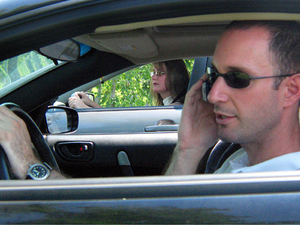Can simultaneous driving and talking on a cell phone be hazardous to your health?
For the millions of Americans that have witnessed a wavering car on the road with a driver talking on a cell phone, the answer to the above question is, “Yes”.
It’s a common scene. Late afternoon traffic in a metropolitan city, with bumper-to-bumper vehicles edging slowly towards home. You shift a glance at a driver in a car riding alongside yours, only to notice them talking and stressed on a cellular phone. The traffic starts to pick up, but by then the driver has become so absorbed in their cell phone conversation with someone they know on the other end, that they forget traffic is moving. Completely un-focused, the inevitable happens – a car accident.
Who’s fault is it? Somehow, the cell phone quickly disappears.
Point blank – cell phone drivers have proven to be dangerous. If the mortality rate hasn’t gone up, then car insurance premiums will. It doesn’t matter who’s fault it is. Vehicle rates of insurance will still go up. However, losing money is one issue. Lost lives are another.
Though police authorities have started to slowly crack down on drivers with cell phones, the message isn’t coming out strong enough. Drivers are still shirking road-driving responsibilities and continue to do as they please with their cell phones while jeopardizing not only their lives, but the lives of other people. They refuse to take the mandatory driving action: both eyes on the road.
There’s also the problem of trying to prove the driver had a cell phone in their hand while driving.
Here are some interesting statistics. According to the journal’s publisher, the Human Factors and Ergonomics Society, cell phone distraction causes over 2,500 deaths and 330,000 injuries in the United States every year.
In a past study shown, drivers talking on mobile phones were 18 percent slower to react to brake lights and 17 percent longer to regain the speed they lost when they braked. Naturally, that would frustrate other motorists.
As well, a study conducted earlier by the National Center for Statistics and Analysis of the NHTSA (Acronym: National Highway Traffic Safety Administration) indicated the usage of cellular phones in cars had increased from 5 percent of motorists using them nationwide in 2004 compared to 6 percent in 2005. The 2005 survey showed that an estimated 10 percent of vehicles were driven by a motorist using a cell phone, whether hand-held or hands-free.
In Washington state alone, between January and September 2006, cell phones contributed to 889 crashes, or less than 1 percent of the 101,499 crashes reported, according to the most recent Transportation Department data available. One of the cell-phone related crashes was fatal.
Today, despite the ever increasing worldwide cell phone usage, only several countries, three states and Washington, D.C. have banned the use of hand-held cell phones while driving.
If motorists insist on keeping cell phones in their cars, they should only be used for one reason only: Calling 911 for emergency situations. It’s not difficult to tuck a cell phone in a glove compartment for this need alone. Cell phones should save lives, not kill them.
Sources:
Human Factors and Ergonomics Society
NHTSA: National Highway Traffic Safety Adminstration






